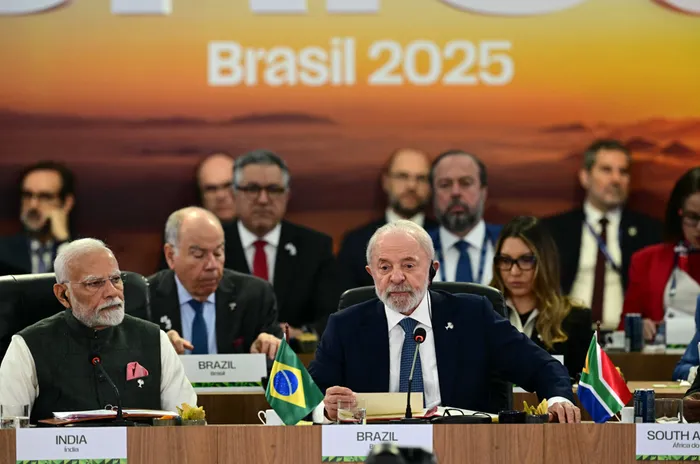BRICS: Economic Power, Soft Power or Both?

India's Prime Minister Narendra Modi (L) and Brazil's President Luiz Inacio Lula da Silva attend a plenary session of the BRICS summit in Rio de Janeiro, Brazil, on July 7, 2025. BRICS leaders at a summit on Sunday took aim at US President Donald Trump's "indiscriminate" import tariffs and recent Israeli-US strikes on Iran.
Image: AFP
BRICS, more recently, BRICS+ is playing an increasingly prominent role on the global stage through both its economic strength and growing diplomatic influence. Representing nearly half the world’s population and a substantial portion of global GDP and trade, the group has demonstrated clear economic power. At the same time, its efforts to promote multilateralism, cultural exchange, and peaceful conflict resolution reflect a deliberate use of soft power. Its core focus areas—political cooperation, financial development, and people-to-people engagement—showcase a blend of hard and soft influence. From launching the New Development Bank to encouraging trade in local currencies and hosting youth and academic forums, BRICS is a formidable force in a shifting global order.
BRICS upholds three main pillars: (1) political and security; (2) economic and financial; and (3) cultural and people to people cooperation. Regarding pillar (1) the grouping addresses global security issues and aims to improve global governance through the promotion of multilateralism. For example: BRICS foreign ministers convene routinely on the sidelines of the United Nations General Assembly. Their cooperation also extends to areas such as counter-terrorism, cybersecurity, and broader security issues. (2) It enhances trade, investment, financial stability, and promotes sustainable development. For example, Finance ministers from BRICS countries hold frequent meetings, often in parallel with gatherings of the G20 and the IMF/World Bank. Their joint efforts focus on boosting trade among member states, improving the resilience of supply chains, and enhancing financial collaboration in areas like digital innovation and sustainable finance. (3) The grouping intentionally cultivates cultural exchange, academic collaboration, and the overall strengthening of people-to-people connections. For example, BRICS hosts a range of activities and programmes, such as scholarly forums, cultural celebrations, and youth exchange initiatives. If this makes the reader think that the grouping is just a talkshop, recent developments have proven the opposite.
BRICS is seen as an economic power due to its aforementioned global standings in terms of GDP and resources. It is supported by the world’s second-largest economy, China, and others like India; Brazil; and Russia. The grouping holds 24% of total global exchanges in international trade. This allows it to have a formidable global economic influence. It owns approximately 72% of the globe’s reserves of rare earth metals; 43.6% of global oil production; 36% of the world’s natural gas production; and 78.2% of the global production of mineral coal. It has, through its economic and financial pillar emphasised intra-BRICS trade and equitable global economic development, where BRICS+ countries are provided increased sovereignty regarding its conduct, particularly in trade.
The grouping has established its own bank, known today as the New Development Bank (NDB), discussed in 2014 and established officially in 2015, showed the core BRICS member countries pool finances to form the bank. This allowed for countries to be given loans with fairer loan terms that does not impede on a countries economic sovereignty. This issue was brought to the BRICS Summit in Rio De Janeiro, Brazil, where this “fairer” financial model was discussed as a major step in global transformation regarding multilateral financial institutions like the World Bank and International Monetary Fund (IMF). The NDB, however, has to think carefully if it wants to be increasingly efficient in this “fairer” model as it is still institutionally tied to the US dollar and concomitant US sanctions against other BRICS members.
In the spheres of finance and currency at the BRICS summit, there was a realistic atmosphere seeing the replacement of the United States (US) dollar with a coordinated system, not dominated but shared by many currencies as an unrealistic endeavour in the near future. Here it is important to note that the grouping does not wish to destroy the US dollar but rather create a fairer global financial system. The grouping is thus of the opinion that BRICS countries should increase trade in their own currencies as a mitigating force regarding US dollar dominance.
In alignment with BRICS’ mission to address global issues and insecurity through the promotion of multilateralism, BRICS has signed the Non-Aligned Movement (NAM) agreement, where it pledged no formal alliance with any major power bloc. The grouping believes in a non-violent approach to conflict through dialogue. This, however, does not mean that the grouping will be mum to wrongs committed by one country/countries toward another. The BRICS summit received global attention, particularly when calling out the US for its attack and Iran–during its confrontation with Israel–arguably exacerbating conflict within the region–Iran attacked the US base in Qatar soon after. In the Russia and Ukraine conflict, the grouping has continued to facilitate a peaceful settlement of conflict between the two countries.
BRICS is neither solely an economic powerhouse nor purely a soft power bloc; it is a strategic blend of both. Its significant share of global GDP, abundant natural resources, and strong presence in international trade demonstrate clear economic strength. At the same time, its emphasis on multilateralism, cultural exchange, and peaceful conflict resolution reflects a conscious use of soft power. Through its three interconnected pillars: political and security cooperation; economic and financial collaboration; and people-to-people engagement, BRICS promotes a global model based on fairness, sovereignty, and inclusive development. Whether through the NDB’s efforts to increase trade in local currencies, or cultural and academic initiatives, BRICS is using economic leverage to build credibility while advancing soft power to influence global norms and foster cooperation.
By: Cole Jackson
Lead Associate
Chinese & South American Specialist
* MORE ARTICLES ON OUR WEBSITE https://bricscg.com/
** Follow @brics_daily on X/Twitter & @brics_daily on Instagram for daily BRICS+ updates